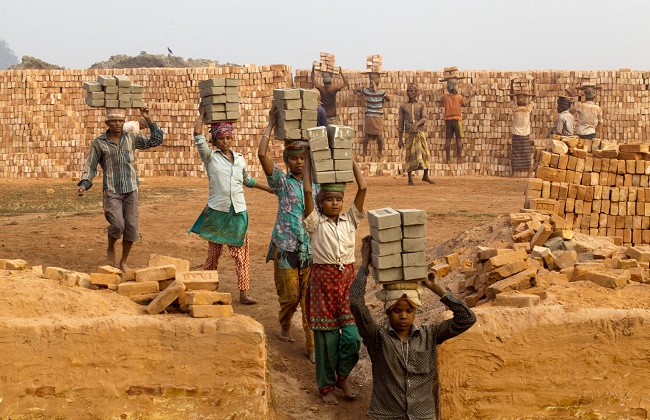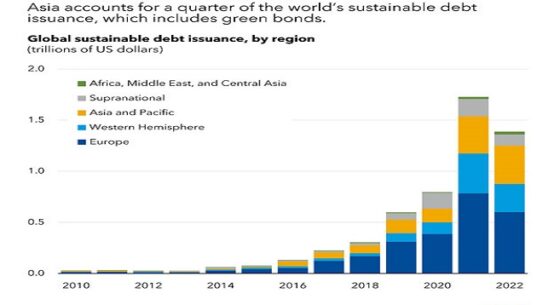
With rising demand for infrastructure development in Bangladesh, both private and public, the demand for bricks has increased over the decades. To meet the demand, production has also risen. The entire process damages the country’s environment in two ways: Increased air pollution and decreased soil fertility, as the current brickmaking methods depend on topsoil.
The Department of Environment, estimates that the nation’s 7,000 or so brickfields currently use 3,350 million cubic feet of topsoil or clay annually as a raw material to produce around 23 billion bricks.
Usually, after topsoil is removed, the land remains uncultivable and fallow for the next few years, which ultimately reduces agricultural production.
A study, says the construction industry is accountable for a significant portion of greenhouse gas emissions (30%), with an additional 18% resulting from indirect material exploitation and transportation. One million bricks are produced using about 240 tons of coal.
It reads that about 23,300 tons of particulate matter, 1.8 million tons of carbon dioxide, 302,000 tons of carbon monoxide and other highly hazardous compounds are released from brick kilns annually in the Dhaka region alone.
Considering the issues, the government decided to phase out conventional brickmaking methods and use alternative bricks, from concrete, sand and dredged soil from riverbeds.
“We have decided to use alternative bricks from this year for official constructions primarily,” said Saber Hossain Chowdhury, the environment, forest and climate change minister, adding that conventional brick kilns will be gradually shut down and converted for alternative brickmaking so the country can stop using topsoil and cut air pollution in the next few years.
The Bangladesh Housing and Building Research Institute (HBRI), shows in its research and development how the country could save a huge amount of topsoil by using alternative bricks and building materials instead of the traditional bricks made from agricultural topsoil, which is essential to ensure soil fertility.
As an example, they have already developed several alternative building materials, including compressed stabilized earth blocks (CSEBs), interlocking CSEBs, hollow concrete blocks, thermal blocks, aerated concrete, and ferrocement sandwich panels, which can easily be replaced with bricks made with alternative materials.
“These building materials can easily be used for constructing buildings in the country’s rural and urban areas, which will reduce the pressure of topsoil as those do not require any soil,” said Md. Ashraful Alam, director general of HBRI.
The research body has used materials other than topsoil, including dredged soil, sand, cement and iron.
For example, he also said that a CSEB is made from dredged river soil mixed with proportionate cement. The production cost of CSEB is nearly half of conventional burnt brick.
Meanwhile, the research body has demonstrated the use of such materials by constructing buildings and housing for disaster-prone areas and cyclone shelters, creating awareness among people by showcasing these, and training local masons in using the materials.
How does the brickmaking law support alternatives?
According to the Bangladesh Brickmaking and Brick Field (Control) Act 2019, a “brick” means a thing that is made from soil, sand and cement.
The existing brickmaking law has incorporated several things that indirectly discourage conventional brickmaking rather than encourage modern brickmaking technology and alternative bricks.
Primarily, the law creates a bar to using topsoil on agricultural land. At the same time, it defines agricultural land as producing crops more than once a year.
According to the Ministry of Agriculture, the country’s total arable land is 8.8 million hectares (21.7 million acres). Of those, 2.1 million hectares (5.2 million acres) are single-cropped, 4.1 million hectares (10.1 million acres) are double-cropped, and 2.2 million hectares (5.4 million acres) are multi-cropped.
As per the law, nobody can take soil from agricultural land, hills or tila (small hills) to make bricks. The law does not permit taking soil from different places, including moja ponds (ponds that dry during summer), canals, beels (wetlands), rivers, wetlands, char (river islands) and fallow lands.
According to the Bangladesh Brick Manufacturing Owners Association, the brickmaking industry is one of the fastest-growing in Bangladesh, earning annual revenue of around 8.66 billion taka ($78.9 million).
“The government should consider the issue of using soil type in the industry, as the current act does not permit using topsoil and soils from agricultural lands, which ultimately prohibits the use of all kinds of soil. The irony is that the country’s brick industry depends on soil as a raw material,” said Firoz Haider Khan, president of the Bangladesh Brick Manufacturing Owners Association.
Praising the government’s move for alternative bricks, he said, “If the market demand could be created through promotion, we eagerly will convert our business from burnt brick to nonburnt alternative bricks.”
(This article is republished from Mongabay under Creative Commons License)
Abu Siddique is Mongabay’s Contributing Editor for Bangladesh. He has worked for several of the leading national dailies including Dhaka Tribune, Daily Sun and The Business Standard, and has explored the remotest corners of the country in search of stories.

